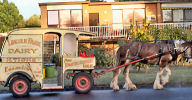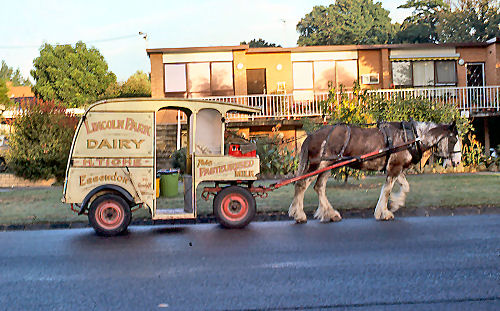 It was 1959 and I was in grade 5. I can remember hearing this population statistic; Australia's population had reached 10 million. I was one of 10 million. It was the first time I had ever been aware of the population of Australia. When my mother was born in 1918 it was 5 million It took another 45 years for the population to double from 10 million to 20 million.
It was 1959 and I was in grade 5. I can remember hearing this population statistic; Australia's population had reached 10 million. I was one of 10 million. It was the first time I had ever been aware of the population of Australia. When my mother was born in 1918 it was 5 million It took another 45 years for the population to double from 10 million to 20 million.

So what was Australia like when the population was 10 million?
Well, if you drove up the Hume highway to Albury, it was a 2 lane gum tree lined road, and you went through every town. So it wasn't such a big decision to stop along the way because you were not coming off a motorway and covering more miles. (Yes miles, we were still in imperial measurements.)
There was far less obvious infrastructure in the suburbs, less concrete involved in bus stops and tram stops, fewer roundabouts. The population was, however, growing and so you did see building works going on, but they were for free standing ordinary sized houses on what had been vacant blocks. You did not see the mass demolitions of today and replacements with much higher density construction. Roadworks were the exception, unlike today, where you run into detours and narrowing lanes all the time.
The population did not stay at 10 million; not for one day. It kept on growing. 1 million migrants arrived between 1945 to 1955 and of course were still coming in 1959. On top of that there was a baby boom (over 200,000 babies were born) and it seems to me now that every second woman was wheeling a pram. Our way of life was not static but, to me, being a child, it almost appeared that way because my perception of time was so stretched out compared with the concertina effect of time now in my senior years.
I do remember being a bit aware of migration to Australia, as the newspapers would, from time to time, make a news item out of a particularly photogenic family. One I can remember was a large blond northern European or Dutch family with 7 or 8 children all smiling as they descended the gangplank of their ship on arrival in Melbourne.
Many migrants spent time in Bonegilla migrant camp when they arrived in Australia. There was a housing shortage as there had been little construction during the war and so they made do with semi cylindrical corrugated iron huts. A relative of mine was the doctor at Bonegilla and because of this I visited the camp at least once. The day I can remember was sunny and warm and the place looked quite pleasant to me although I have read many complaining accounts of the basic nature of the place and the monotonous food from those who have passed through. I know this migrant influx put a huge strain on the education system in the surrounding area. I was told there were 50 pupils in my cousin's class at school in grade two compared with half that at my private school in Melbourne
We lived near a main road on which the traffic was quite fast and heavy during "peak hour". Peak hour was in fact only one hour each end of the day. Our dog still managed to get run over on this road resulting in a broken pelvis. Fortunately he recovered.In the street where we lived there was far less traffic and very little during the day so we could use the road for roller skating and billy carts.
With respect to dogs at that time it was quite normal to see dogs walking the street in the day time without their owners. To me they usually appeared purposeful as though they might have been visiting a friend down the street. Somehow they learned some road sense and could be trusted . The increasing traffic soon made this impossible necessitating leads and designated walks with owners in charge.
Writing about Australia with a population of 10 million, it is tempting to indulge in nostalgia about the way things were done which may or may not actually be related to the wonderfully small size of the population. For instance the fact that my mother hardly had to go out to shop for food at all seems very attractive compared with my supermarket excursions and the battle for the carpark. In 1959 our meat, milk, bread, groceries, green groceries all had separate deliveries. The grocer, green grocer and butcher all came to the back door and took my mother's order. They would then bring it back to her from the van parked outside the house. Bread and milk were a standing order and delivered delivered early each morning to the front door. Shopping could not be any easier than that!
Our favourite places to spend leisure time were the beach in summer and maybe play in the back yard or riding bicycles in the cooler months. We could park the car at the beach for as long as we wanted, free. Now our time at the beach is metred and measured and therefore far less relaxing. Now it is an advantage to have a friend with a disabled parking permit just to ease the stress of parking the car.
When Australia's population was only 10 million it was easy to get out into the countryside around Melbourne as it was so close by. Cows grazed in green fields in what is now the suburb of Dingley. My father used to complain about other drivers just as we do now but there weren't as many of them.
One stark difference between Australia with 10 million, and now with 25 million, is that land was less defined and deliberately purposed. It was not as fiercely contested, not as "valuable" as it is now. At my school with 250 pupils we had about an acre of what I remember as almost virgin bush. We had wildlife emerging from it occasionally; a possum and a lizard at least! We didn't venture into it at play time as I think it was too thickly vegetated but we played on its perimeter and sat together on old gnarled, horizontally growing ti-tree branches polished over many years from this repeated use. That bushland has gone now. Some of it disappeared to make an oval for sports whilst I was still at the school.
There was a nature sanctuary quite near where we lived and a swamp across the busy road from where children collected tadpoles. This swamp had been drained before I reached secondary school level and a new school built to accommodate the children of the area as they exited their various primary schools. In the same period the vacant blocks of land nearby to where we lived, with their resident horses with names who we would visit, also were built on and the horses disappeared.
Things were changing quite quickly although I was too young to notice. I was changing and my life was changing so I did not grieve with each lost pleasure as I do now when population growth and development claim the little pockets of my area that everyone could once enjoy. I did not back then stop to ponder that what I was losing was being lost to everyone forever. How could I have known? I did not understand the implications any more than young people do today, although changes are now happening so much faster.

Add comment